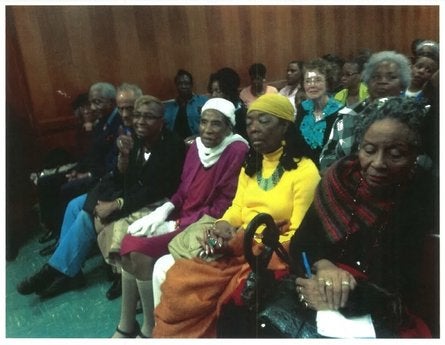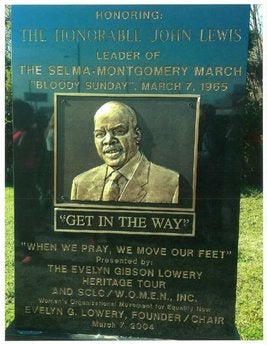Our history department staff colleague Sandra Hopwood recently returned to her home state of Alabama to take part in the commemorative events related to one of the milestone events of the modern Civil Rights era. On March 7, 1965 – “Bloody Sunday” – civil rights proponents marching from Selma to Montgomery were beaten by Alabama state troopers as they crossed the Edmund Pettus Bridge. Sandra remembers the events of that day, and she reflects upon the event and its 49th anniversary in the brief essay which follows.
William Deverell, Chair (2014-2016)
Department of History, USC
Director, Huntington-USC Institute on California and the West
“BLOODY SUNDAY”
SELMA, ALABAMA 2014 JUBILEE
On March 6, 1965, African-Americans gathered in Brown Chapel Church in Selma, Alabama preparing for an important march to the state capitol for the rights to vote. This day is now referred to as “Bloody Sunday” and is celebrated annually on the 2nd weekend of March by re-enacting the day’s events. On “Bloody Sunday” I horrifically watched my family members, teachers, friends and other freedom fighters get run over by horses, beat down with clubs, and even have water hoses turned on them as they marched for the right to vote.
I want to thank Bill Deverell and the History Department of USC for giving me the opportunity to participate in this years’ celebration. This was the 49th year and it was truly incredible.
Marching across the Edmund Pettus Bridge was truly riveting. Chills were brought to my body simply thinking about all of the people who crossed it before me, and the evil acts they had endured. It was indeed an awesome and moving experience and I very much look forward to returning.
 |
| Sandra Hopwood (right) poses during the march across the Edmund Pettus Bridge for the 49th Jubilee celebration of “Bloody Sunday”. |
Although it was a heart-wrenching and intense experience in its entirety, my favorite part was the King Unity Breakfast, where I was able to hear speeches of the famous historians that marched in 1965 and continue to march to this day. To listen to these first-hand accounts was absolutely the most life-changing event that I have experienced.
I was able to meet and hear Dick Gregory speak, which was powerful beyond words. It was such an honor to shake his hand and he allowed me to take his picture, for which I am so humbled.
 |
| Dick Gregory, comedian, civil rights activist, social critic, writer, and entrepreneur |
The gymnasium of Selma’s Wallace Community College was filled with an overwhelming spirit of power as Rev. Jesse Jackson (founder and president of the Rainbow People United to Save Humanity Coalition), Dr. William Barber (a National Association for the Advancement of Colored People board member), and Academy Award Winning actor Louis Gossett Jr. (founder of the Eracism Foundation), spoke at the King Breakfast along with local, Rev. F. D. Reece. Rev. F. D. Reese was my math teacher in high school and also my neighbor while growing up in Selma.
One of the most memorable events I attended focused on a Black man named Jimmie Lee Jackson who was gunned down and murdered at a Selma protest on the rights to vote, by state trooper James Fowler. Fowler would later stand trial for the murder of Jimmie Lee Jackson, 41 years later in 2006. Fowler never denied killing Jimmie Lee Jackson and was free to brag about it. In 2006 he was finally convicted of murder but, was so old, he spent less than six months in prison.
Gov. George C. Wallace gave the order to the troopers to stop the protestors by any mean necessary. This being said, Fowler felt justified in shooting Jimmy Lee Jackson. Jackson’s family was never able to file a civil suit against the state of Alabama so we had the opportunity to hold a mock trial; The family of Jimmy Lee Jackson v. The State of Alabama. It was great! For the defense we had Gov. Wallace Butler, who testified that he heard the governor give the order to use force. The entire trial was mind-blowing and I was even selected to be on the jury; I couldn’t ask for anything more.
 |
| Crowd members at the mock trial of Jimmy Lee Johnson vs. The State of Alabama. |
Also present at the trial was Amelia Boynton Robinson, one of the leaders of the civil rights movement in Selma’s 1965 march to Montgomery, Alabama. She was also one of the first black women to qualify to vote. She, along with Reverend Reece established the Dallas County Voters League. The two of them invited Martin Luther King, Jr. to Selma for a voting rights campaign, and her home then became the center of the Selma, Alabama Civil Rights Campaign. In the 1965 march from Selma to Montgomery, she was beaten unconscious. It was a photo of her lying on the Edmund Pettus Bridge that brought worldwide attention to the tragic events that were taking place, all in an effort to keep African-Americans from the right to vote. She is currently 102 years old and to meet her and shake her hand was such an honor.
 |
| Amelia Boynton Robinson, center. |
I also got a chance to visit the National Voting Rights Museum located at the foot of the Edmund Pettus Bridge, which was equally inspiring. On display are items such as water fountains labeled ‘Colored’ and ‘White’, various actual foot soldiers’ footprints, as well as the Non-violence and Voting Booth exhibits (among others). I was even able to view the exact jail cell where Martin Luther King, Jr. was housed after he was arrested. Included in this paper are pictures taken from that museum.
 |
 |
| Plaques located at the National Voting Rights Museum at the foot of the Edmund Pettus Bridge. | |
Thank you to the USC History Department for giving me the opportunity to visit my hometown and be a part of the re-enactment of Bloody Sunday. This event is not only a part of Black history, but American history as it played a critical role in Lyndon B. Johnson ultimately signing the Voting Rights Act of 1965.